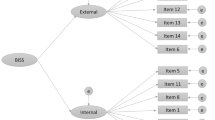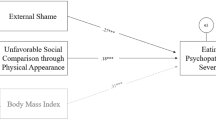Abstract
Purpose
The purpose of the present study was to explore the relative contributions of self-blame and internalized shame to variability in disordered eating and drive for muscularity scores in collegiate men.
Method
One hundred and sixty-eight male college students in the Rocky Mountain region of the USA completed valid and reliable self-report survey measures: the Drive for Muscularity Scale, the Internalized Shame Scale, the Shame and Guilt Eating Scale to assess self-blame, and the Eating Attitudes Test. Cross-sectional data were analyzed through descriptive, correlation, and regression statistics.
Results
Men who reported higher levels of self-blame, r = 0.39, p < 0.001, and internalized shame, r = 0.38, p < 0.001, also reported higher levels of eating disorder symptomology. Similarly, men who scored higher on internalized shame, r = 0.20, p < 0.01, reported higher scores on drive for muscularity. Regression analyses revealed that internalized shame was the sole contributor to variability in drive for muscularity scores, β = 0.20, p < 0.01, whereas both self-blame, β = 0.27, p < 0.001, and internalized shame, β = 0.24, p < 0.001, contributed to scores on disordered eating attitudes and behaviors in men.
Conclusions
Our study was the first to examine how internalized shame and self-blame relate to drive for muscularity and disordered eating in collegiate men. Our results suggest that both self-blame and internalized shame may contribute to disordered eating in men. Additionally, internalized shame appears to relate to drive for muscularity in men. Clinicians may wish to consider how they approach treatment given the potential contributions of internalized shame and self-blame to disordered eating in their male clients.
Level of evidence
Level V, cross-sectional descriptive study.
Similar content being viewed by others
References
Combs JL, Pearson CM, Zapolski TC, Smith GT (2013) Preadolescent disordered eating predicts subsequent eating dysfunction. J Pediatr Psychol 38:41–49. https://doi.org/10.1093/jpepsy/jss094
Tod D, Edwards C (2015) A meta-analysis of the drive for muscularity's relationships with exercise behaviour, disordered eating, supplement consumption, and exercise dependence. Int Rev Sport Exerc Psychol 8:185–203. https://doi.org/10.1080/1750984X.2015.1052089
Locker T, Heesacker M, Baker J (2012) Gender similarities in the relationship between psychological aspects of disordered eating and self-silencing. Psychol Men Masc 13:89–105. https://doi.org/10.1037/a0021905
Haynos A, Wall M, Chen C, Wang S, Loth K, Neumark S (2018) Patterns of weight control behavior persisting beyond young adulthood: results from a 15‐year longitudinal study. Int J Eat Disord. https://doi.org/10.1002/eat.22963
Bucchianeri M, Arikian A, Hannan P, Eisenberg M, Neumark-Sztainer D (2013) Body dissatisfaction from adolescence to young adulthood: findings from a 10-year longitudinal study. Body Image 10(1):1–7. https://doi.org/10.1016/j.bodyim.2012.09.001
Lavender J, De Young K, Anderson D (2010) Eating Disorder Examination Questionnaire (EDE-Q): norms for undergraduate men. Eat Behav 11:119–121. https://doi.org/10.1016/j.eatbeh.2009.09.005
Neighbors L, Sobal J (2007) Prevalence and magnitude of body weight and shape dissatisfaction among university students. Eat Behav 8:429–439. https://doi.org/10.1016/j.eatbeh.2007.03.003
Hobza C, Rochlen A (2009) Gender role conflict, drive for muscularity, and the impact of ideal media portrayals on men. Psychol Men Masc 10:120–130. https://doi.org/10.1037/a0015040
Erol A, Toprak G, Yazici F (2006) Psychological and physical correlates of disordered eating in male and female Turkish college students. Psychiatry Clin Neurosci 60:551–557. https://doi.org/10.1111/j.1440-1819.2006.01557.x
Cohen D, Petrie T (2005) An examination of psychosocial correlates of disordered eating among undergraduate women. Sex Roles 52:29–42. https://doi.org/10.1007/s11199-005-1191-x
Solmi F, Hatch L, Hotopf M, Treasure J, Micali N (2014) Prevalence and correlates of disordered eating in a general population sample: The South East London Community Health (SELCoH) study. Soc Psychiatry Psychiatr Epidemiol 49:1335–1346. https://doi.org/10.1007/s00127-014-0822-3
Swami V, Hadji-Michael M, Furnham A (2008) Personality and individual difference correlates of positive body image. Body Image 5:322–325. https://doi.org/10.1016/j.bodyim.2008.03.007
Klimek P, Murray SB, Brown T, Gonzales M IV, Blashill AJ (2018) Thinness and muscularity internalization: associations with disordered eating and muscle dysmorphia in men. Int J Eat Disord 51:352–357. https://doi.org/10.1002/eat.22844
Farrell N, Lee A, Deacon B (2015) Biological or psychological? Effects of eating disorder psychoeducation on self-blame and recovery expectations among symptomatic individuals. Behav Res Ther 74:32–37. https://doi.org/10.1016/j.brat.2015.08.011
Björk T, Skårberg K, Engström I (2013) Eating disorders and anabolic androgenic steroids in males: Similarities and differences in self-image and psychiatric symptoms. Subst Abuse Treat Prev 8:30. https://doi.org/10.1186/1747-597X-8-30
Ward R, Hay M (2015) Depression, coping, hassles, and body dissatisfaction: factors associated with disordered eating. Eat Behav 17:14–18. https://doi.org/10.1016/j.eatbeh.2014.12.002
Amoss S, Lynch M, Bratley M (2016) Bringing forth stories of blame and shame in dialogues with families affected by adolescent self-harm. J Fam Ther 38:189–205. https://doi.org/10.1111/1467-6427.12101
García-Grau E, Fusté A, Miró A, Saldaña C, Bados A (2004) Coping style and vulnerability to eating disorders in adolescent boys. Eur Eat Disord Rev 12:61–67. https://doi.org/10.1002/erv.550
Bessenoff G, Snow D (2006) Absorbing society's influence: Body image self-discrepancy and internalized shame. Sex Roles 54:727–731. https://doi.org/10.1007/s11199-006-9038-7
Martins Y, Tiggemann M, Kirkbride A (2007) Those speedos become them: the role of self-objectification in gay and heterosexual men's body image. Pers Soc Psychol Bull 33:634–647. https://doi.org/10.1177/0146167206297403
Eik-Nes TT, Austin SB, Blashill AJ, Murray SB, Calzo JP (2018) Prospective health associations of drive for muscularity in young adult males. Int J Eat Disord. https://doi.org/10.1002/eat.22943
Oberle CD, Lipschuetz SL (2018) Orthorexia symptoms correlate with perceived muscularity and body fat, not BMI. Eat Weight Disord 23:363–368. https://doi.org/10.1007/s40519-018-0508-z
Oliveira S, Trindade I, Ferreira C (2018) Explaining male body attitudes: the role of early peer emotional experiences and shame. Eat Weight Disord. https://doi.org/10.1007/s40519-018-0569-z
Mustapic J, Marcinko D, Vargek P (2015) Predictors of drive for muscularity among adolescent males. Stud Psychol 57:203–213. https://doi.org/10.21909/sp.2015.03.694
Shepherd C, Rickard K (2012) Drive for muscularity and help-seeking: the mediational role of gender role conflict, self-stigma, and attitudes. Psychol Men Masc 13:379–392. https://doi.org/10.1037/a0025923
O'Hara L, Tahboub-Schulte S, Thomas J (2016) Weight-related teasing and internalized weight stigma predict abnormal eating attitudes and behaviours in Emirati female university students. Appetite. https://doi.org/10.1016/j.appet.2016.01.019
Dakanalis A, Di Mattei V, Bagliacca E, Prunas A, Sarno L, Riva G, Zanetti M (2012) Disordered eating behaviors among Italian men: objectifying media and sexual orientation differences. Eat Disord 20:356–367. https://doi.org/10.1080/10640266.2012.715514
Cook D (1987) Measuring shame: The Internalized Shame Scale. Alcohol Treat Q 4:197–215. https://doi.org/10.1300/J020v04n02_12
Goldschmidt A, Wall M, Loth K, Le Grange D, Neumark-Sztainer D (2012) Which dieters are at risk for the onset of binge eating? A prospective study of adolescents and young adults. J Adolesc Health 51:86–92. https://doi.org/10.1016/j.jadohealth.2011.11.001
Goldschmidt A, Wall M, Loth K, Bucchianeri M, Neumark-Sztainer D (2014) The course of binge eating from adolescence to young adulthood. Health Psychol 33:457–460. https://doi.org/10.1037/a0033508
Øen G, Kvilhaugsvik B, Eldal K, Halding A (2018) Adolescents’ perspectives on everyday life with obesity: a qualitative study. Int J Qual Stud Health Well-being 13:1479581. https://doi.org/10.1080/17482631.2018.1479581
Oluyori T (2013) A systematic review of qualitative studies on shame, guilt and eating disorders. Coun Psychol Rev 28:47–59
Sanftner J, Barlow D, Marschall D, Tangney J (1995) The relation of shame and guilt to eating disorder symptomatology. J Soc Clin Psychol 14:315–324. https://doi.org/10.1521/jscp.1995.14.4.315
McCreary D, Sasse D (2000) An exploration of the drive for muscularity in adolescent boys and girls. J Am Coll Health 48:297–304. https://doi.org/10.1080/07448480009596271
Frank E (1990) Shame and guilt in eating disorders. Diss Abstr Int 50:3896A
Garner D, Olmsted M, Bohr Y, Garfinkel P (1982) The Eating Attitudes Test: psychometric features and clinical correlates. Psychol Med 12:871–878
Neumark-Sztainer D, Wall M, Story M, Standish A (2012) Dieting and unhealthy weight control behaviors during adolescence: associations with 10-year changes in body mass index. J Adolesc Health 50:80–86. https://doi.org/10.1016/j.jadohealth.2011.05.010
Naeimi A, Haghighian H, Gargari B, Alizadeh M, Rouzitalab T (2016) Eating disorders risk and its relation to self-esteem and body image in Iranian university students of medical sciences. Eat Weight Disord 21:597–605. https://doi.org/10.1007/s40519-016-0283-7
Claesson K, Sohlberg S (2002) Internalized shame and early interactions characterized by indifference, abandonment and rejection: replicated findings. Clin Psychol Psychother 9:277–284. https://doi.org/10.1002/cpp.331
Eisenberg M, Franz R, Berge J, Loth K, Neumark-Sztainer D (2017) Significant others’ weight-related comments and their associations with weight-control behavior, muscle-enhancing behavior, and emotional well-being. Fam Syst Health. 35:474–485. https://doi.org/10.1037/fsh0000298
Bennett D, Ambrosini P, Kudes D, Metz C, Rabinovich H (2005) Gender differences in adolescent depression: do symptoms differ for boys and girls? J Affect Disord 89:35–44. https://doi.org/10.1016/j.jad.2005.05.020
Lamont J (2018) Body shame and health information seeking: the roles of body responsiveness and perceived control over health. Diss Abstr Int 78:11-B(E)
Funding
There was no funding for this study.
Author information
Authors and Affiliations
Corresponding author
Ethics declarations
Conflict of interest
The authors declare that that they have no conflicts of interest.
Ethical approval
All procedures performed in studies involving human participants were in accordance with the ethical standards of the institutional and/or national research committee and with the 1964 Helsinki Declaration and its later amendments or comparable ethical standards.
Informed consent
Informed consent was obtained from all individual participants included in the study.
Additional information
Publisher's Note
Springer Nature remains neutral with regard to jurisdictional claims in published maps and institutional affiliations.
This article is part of topical collection on Males and eating and weight disorders.
Rights and permissions
About this article
Cite this article
Larison, B., Pritchard, M. The effects of internalized shame and self-blame on disordered eating and drive for muscularity in collegiate men. Eat Weight Disord 24, 653–660 (2019). https://doi.org/10.1007/s40519-019-00700-0
Received:
Accepted:
Published:
Issue Date:
DOI: https://doi.org/10.1007/s40519-019-00700-0




